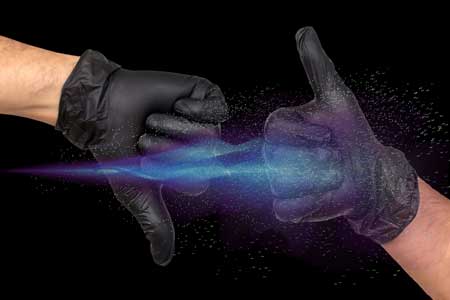


Click
on the image to download a print quality scan
The humble rubber glove has become surprisingly sophisticated and now ranges over at least three categories, six specific and numerous more generic international standards. There are also two competing issues – preventing moisture getting in but still allowing the hand to breathe.
The solution is, necessarily, a compromise – but a different compromise for each Category, Standard and often for specific applications. And this is where Versaperm, a specialist in vapour permeability comes in with their latest range of measurement systems.
Some modern glove designs can even offer different permeabilities and abrasion resistance for various parts of the glove.
A fully vapour impermeable glove will rapidly become hot, wet and uncomfortable to wear, this can lead to various skin problems. On the other hand the glove needs to prevent toxic or harmful substances from permeating in.
Either developing a new glove or the on-going quality control of both the finished gloves and their component materials, require testing. Versaperm's equipment is typically accurate in the Parts Per Million (PPM) range (PPB in some cases), it can measure several materials or finished gloves at the same time under a variety of environmental conditions such as temperature and humidity.
The equipment is highly automated making it simple to use, fast and precise.
Surprisingly, although liquids, such as water or blood, are relatively simple to keep out with a good seal, their vapours often permeate straight through the glove. Many excellent traditional water barrier materials, such as cellulose, EVOH or PVOH, are virtually useless as vapour barriers – which could lead to catastrophic results.
ENDS
A technical note on categories and standards
Category I: Gloves of simple design for minimal risk only e.g. janitorial gloves. Manufacturers are permitted to test and certify gloves internally and there is no requirement for testing and certification by an independent body.
Category II: Gloves for intermediate risk applications such as general handling requiring good cut, puncture and abrasion performance. These are subject to independent testing. Gloves of this category are CE marked.
Category III: Gloves of complex design for irreversible or mortal risks. These gloves protect against the highest levels of risk and require certification from a notified body. These gloves are also CE marked.
EN420:2003 A general requirements for protective gloves
EN374:2003 Gloves giving protection from chemicals and micro-organisms
EN388:2003 Gloves giving protection from mechanical risks
EN407:2004 Gloves giving protection from thermal hazards
EN511:2006 Gloves giving protection from cold
EN421:2010 Gloves giving protection from radioactive contamination and ionising radiation
Please send
any sales enquiries to Christopher Roberts, Versaperm Limited ,
10 Rawcliffe House, Howarth Road, Maidenhead, Berkshire, SL6 1AP, UK, Tel: +44 1628 777668,
e.mail info@versaperm.co.uk Web http://www.versaperm.co.uk
For further Press Information please contact Gerry Palmer @ the Palmer & Rose Partnership. Tel 01494 637499, fax 0871 900 3898 e.mail gerry@palmer-rose.co.uk.